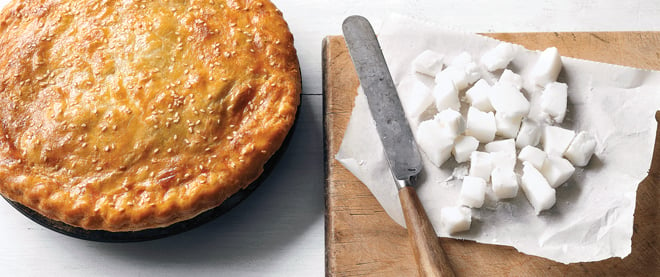Leaf lard makes the flakiest pies
But good luck finding the pork fat at the grocery store
Photograph by John Cullen
Share

A friend recently presented a tempting challenge: if I could locate a kind of animal fat called leaf lard, she would bake one of her perfect fruit pies. A fine home baker, she wanted to test the theory that this dense, mildly flavoured pork fat, which surrounds the animal’s kidneys, is essential to the ultimate in flaky pie crusts.
There are two schools of thought when it comes to pastry: there are the strictly butter types, and those who say lard plus butter equals better results. If so, then leaf fat is the top lard for the job: it has the cleanest taste and a structure that creates pockets of air when its big molecules of fat melt in the oven.
Toronto-based author Jennifer McLagan (who has written three books on animal parts, one of them called Fat) champions the whole-animal movement, which naturally includes the fats. “Leaf lard has a distinctive crystalline texture that makes things tender and delicate in a way no other lard does,” she says. McLagan uses it for pastry as well as french fries, and dishes such as crispy pig ears.
But it is hard to track down. A number of cold calls to small butcher shops in pie haven Montreal and pig central Stratford, Ont., turned up nothing. A bit more digging turned up a clue in How to Read a French Fry, a book about kitchen science by Los Angeles Times food editor Russ Parsons. “Most commercial rendered lard tastes bad,” he writes, adding, “if you ever get a chance to try a pie crust made with good quality lard, jump at it.”
I found leaf lard at two specialty butcher shops in Toronto that deal in rare breed, organic or naturally raised pigs. The Healthy Butcher and Cumbrae’s both sell the lard and make their own pies with it. At T.K. Ranch near Hanna, Alta., rancher Colleen Biggs will harvest the leaf lard when she gets a request from a retailer or a customer. She sells their pastured Berkshire and Duroc pigs to Planet Organic in Edmonton and Community Natural Foods in Calgary, and says the fat of the animal tells the tale of how it was raised.
“Hormones especially tend to get stored in the animal’s fat, so if they are exposed to toxins in their environment, from chemical sprays to being implanted with growth hormones, those will be found in the fat.”
The next question was whether to buy it rendered or unrendered. Both were available at Cumbrae’s at the same price as premium butter, about $3 for 250 grams. An old New York Times article from 2006 warned against the swiney smell and mess of doing it yourself, but McLagan argued she has achieved the best results by turning fat to liquid at home. “Rendering leaf lard is dead easy, but if it gets at all browned or burned, it’s bitter and tastes of pork.” So I tried both.
I gave my friend the baker the rendered leaf lard for an apple pie and rendered my own for a chicken pot pie. McLagan’s blog (jennifermclagan.blogspot.com) offers clear, step-by-step instructions. Bonus: Cumbrae’s sells the leaf lard with the membrane removed, which made the prep easy. The process took eight hours in a low oven. Baking is not my forte, yet the results were good: a crisp and flaky crust, rich but not greasy.
My friend’s pie, baked with a mixture of butter and lard, was a standout. The crust looked marbled, almost like granite, going into the oven. Coming out, it was golden with pearls of pretty fat throughout, less sweet than an all-butter crust. There was not a hint of pig flavour and neither of us detected porky smells in our homes.
Still some bakers won’t touch the stuff. “I’m a butter person,” says pastry chef Joanne Yolles, famous for her coconut cream pie recipe, which is still served at Scaramouche restaurant in Toronto. In part, her aversion is because she is Jewish (although she eats bacon). Others steer clear for dietary reasons. Ilana Kadonoff, founder of the vegan-friendly baking company Sweets From the Earth, says it’s difficult to get flaky crusts using oil, but relies on a solid fat blend of olive, palm and sunflower oils.
Cumbrae’s executive chef Jerry Menses says that although leaf lard is overlooked, some people do ask for it for pies and frying. “They know it’s special.”